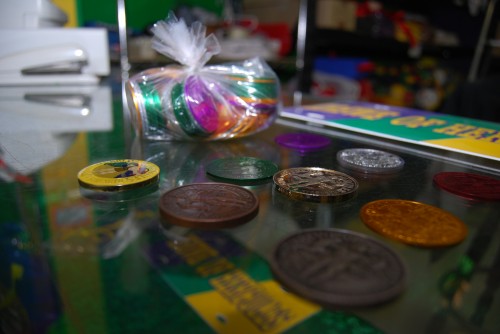
Verda Mae Pugh
December 26, 2012
Three silent films, with live music
January 2, 2013They look like money and clink like metal rapping glass when released with two fists; they represent tradition and are unique to a moment in time.
Each person in relation to Carnival season has a different perspective on doubloons: Riders keep them as souvenirs from previous years and throw them to hear their sound upon striking the pavement; collectors trade them and document a region’s cultural history; parade-goers on a breezy day may struggle to catch the floating discs, but they’ll have a physical memento to remind them of the parade.
On a macro level, thrown doubloons are inexorably linked to Mardi Gras. Less sexy than beads, stuffed animals, coconuts and lacy undergarments, their draw is more in meaning than style.
New Orleans’ Krewe of Rex reportedly first introduced Mardi Gras doubloons in 1960. Painter H. Alvin Sharpe is credited with designing the prototype.
In attempt to stay ahead of the burgeoning parade community, Rex Captain Darwin Fenner ordered 3,000 coins, which were larger and lighter than a silver dollar – similar to the size of the gold Spanish doblón.
The original doubloons were flung in standard-minted aluminum, as well as with gold coloring. The throws were left undated so that they could be used for consecutive years if revelers eschewed them in 1960. They were never again minted without a date.
Krewes across the Gulf Coast followed suit after seeing the success of Rex’s first batch. Most krewes stamp their insignia on one side and that year’s theme on the other, ensuring that no two coins are alike.
Over the past 50-plus years, the coins have become ingrained in Carnival culture. Krewes mint their designs in several different fashions each year, including the heavier, multi-color cloisonné, solid silver and bronze pieces. These heavier doubloons are rarely thrown from floats; instead they are passed hand-to-hand as collectors’ items and mementos.
Aluminum, lightweight doubloons are the ones that frequently rain down from above in several different colors. Their collection value is limited, but they retain the documenting facts of the parade.
Nowadays, doubloons seem to be fading away in the Tri-parish region. There are less clattering coins and more thumping bags of beads, spiraling purple-and-yellow footballs and handed-off novelty wares.
Eddie Bergeron, secretary of the Krewe of Hercules, parks his truck on West Park to catch the nine Houma parades that follow his. He says he’s noticed a slight decline in the number of doubloons thrown during day parades, but a large reduction in the number thrown during the night.
“Once they hit the concrete, they go everywhere,” Bergeron says. “People can’t see them, because the lighting is not that great” during night parades.
Even during the day parades, for revelers, there’s the pressing matter of readying for the next float or even losing them among the Carnival roadway clutter.
Bergeron says the Krewe of Hercules, the Friday night parade that kicks off Mardi Gras in Houma, has cut down its doubloon orders to 10,000 a year, roughly a fourth of what the krewe was buying when he joined 28 years ago. That figure includes heavy and light doubloons.
Hercules boasts close to 700 members, which would equate to about 14 doubloons per rider. Of course, not all riders buy from the pot of 8,000 throw-able doubloons, which cost $35 per 100.
Donnie Braud, the Krewe of Terreanians ball captain for 12 years before stepping down this year, says his club has been consistent in the amount of Mardi Gras coins it orders. He’s not sure if the orders were cut before he got involved with the club but says it probably hasn’t changed by much over the years.
Cecil Bergeron, who owns and operates the Mardi Gras supply warehouse Cajun Enterprises of Houma on the east side, has noticed declined interest in the colorful coins. Less than two months before Fat Tuesday, he has none in stock.
Bergeron will order bundles of generic aluminum doubloons, to be sure, but their popularity has waned, and he can’t pin it on one reason.
“I guess it’s like everything else,” Cecil Bergeron says, “It comes and goes.”
Even the jewelry-like doubloon holders – similar to a wristwatch or necklace with a more-expensive doubloon as the centerpiece – aren’t as popular any more, he says.
The Mardi Gras supplier says the most popular item, by far, is a bag of a dozen 33-inch beads.
“That’s about as small as people go,” he says, before adding he believes that size is the modern-day equivalent of the plastic bead with a connector, colloquially called the junk bead. “They just throw the bag.”
Of course, the ultimate deciders of what gets thrown from floats are the thousands of screaming people along the parade route. Members of the area’s various krewes take note of what is picked up, whether they are spectating from a float or an anchored spot along the route.
And not many willfully spend money to throw something that will be neglected, left on the periphery of pavement or matted grass, destined for the street sweeper or the opportunistic post-parade scavengers with resale on the mind.
–editor@gumboguide.com
The Krewe of Hercules’ nine doubloons are laid on a table in the krewe’s den. All have the same design, but art minted in different fashions. The most popular is the multi-colored cloisonné (top, left), and the most expensive is the pure silver piece in the center ($35).







